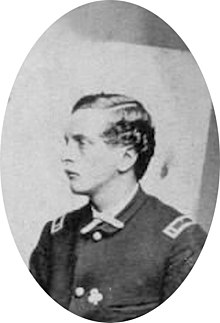William B. Hincks
William B. Hincks | |
|---|---|
 Hincks c. 1865 | |
| Born | 1841 Bucksport, Maine |
| Died | 1903 (aged 61–62) |
| Buried | |
| Allegiance | |
| Service | Union Army |
| Rank | Sergeant Major |
| Unit | |
| Battles / wars | American Civil War |
| Awards | |
William Bliss Hincks (1841 – November 7, 1903) was a Union Army soldier in the American Civil War who received the U.S. military's highest decoration, the Medal of Honor.[1]
Early life
Hincks was born in Bucksport, Maine. He moved to Bridgeport, Connecticut as a boy. Described as a young man of scholastic aptitude and inclination,[2] Hincks put his education on hold to enlist in the Civil War.
Civil War military service
In his regiment, he was said to be a man with strength of mind and purity of purpose, integrity of character, and frankness of manner who could not fail to influence his comrades and win their love and esteem. [3]
Hincks enlisted as a private and rose quickly through the ranks of the regiment. On August 20, 1862 he mustered into "A" Co. Connecticut 14th Infantry as a private, promoted Sergeant in February, 1863, Sergeant Major in June, 1863, Adjutant, in October 1863 and Major in April, 1965. With the exception of a short topur on the brigade staff, Hincks was with the 14th through all its engagements. He was mustered out with his regiment on May 31, 1865, having been in service from Antietam to Appomattox with the 14th Connecticut Regiment.[1]
Medal of Honor
He was awarded the Medal of Honor, for extraordinary heroism on July 3, 1863, while serving as a Sergeant Major with the 14th Connecticut Infantry Regiment, at the Battle of Gettysburg. His Medal of Honor was issued on December 1, 1864.[1]
Citation:
The President of the United States of America, in the name of Congress, takes pleasure in presenting the Medal of Honor to Sergeant Major William B. Hincks, United States Army, for extraordinary heroism on 3 July 1863, while serving with 14th Connecticut Infantry, in action at Gettysburg, Pennsylvania. During the high-water mark of Pickett's charge on 3 July 1863 the colors of the 14th Tennessee Infantry C.S.A. were planted 50 yards in front of the center of Sergeant Major Hincks' regiment. There were no Confederates standing near it but several were lying down around it. Upon a call for volunteers by Major Ellis, commanding, to capture this flag, this soldier and two others leaped the wall. One companion was instantly shot. Sergeant Major Hincks outran his remaining companion running straight and swift for the colors amid a storm of shot. Swinging his saber over the prostrate Confederates and uttering a terrific yell, he seized the flag and hastily returned to his lines. The 14th Tennessee carried 12 battle honors on its flag. The devotion to duty shown by Sergeant Major Hincks gave encouragement to many of his comrades at a crucial moment of the battle.[4][5][1]
Post War
When he returned to chise to go into the mercantile business. He became known for careful and sound judgement and gained him a solid reputation as business advisor. He became custodian for many business trusts. As his business career continued to bloom, he also became vice-president and secretary of many business organizations in Bridgeport. For many years he was treasurer and secretary of the City Saving's Bank of Bridgeport. Hincks helped P.T. Barnum found the Barnum Museum and Bridgeport Hospital. He also wrote about local history.[3]
He married Mary Louise Hart in 1866 and they had three sons. They lived in a house on Park Avenue and Prospect Streets that has since been demolished.[3] He was a deacon in his church and involved in many community activities.
He died at the age of 62, on November 7, 1903, and was buried at the Mountain Grove Cemetery and Mausoleum in Bridgeport, Connecticut.
His son, William Thurston Hincks, was a lawyer who married Maud Morris, who was the vice president of the suffragist movement in Connecticut, and also the first woman in Connecticut to get a drivers license.
See also
Notes
- ^ a b c d Subcommittee on Veterans' Affairs (1968), p. 120.
- ^ Page (1906), p. 156.
- ^ a b c Page (1906), p. 157.
- ^ CMoHS (2020).
- ^ VCOnline (2020).
References
- "Civil War Medal of Honor recipients (A-L)". Medal of Honor citations. United States Army Center of Military History. August 6, 2009. Retrieved July 1, 2010.
- "MOHs - victoriacross". THE COMPREHENSIVE GUIDE TO THE VICTORIA & GEORGE CROSS. VCOnline. 2020. Retrieved 2 May 2020.
- "CMOHS.org - Official Website of the Congressional Medal of Honor Society". Congressional Medal of Honor Society. CMOHS. 2014. Retrieved 19 August 2014.
- Mitchell, Joseph B.; Otis, James (1968). The Badge of Gallantry; Recollections of Civil War Congressional Medal of Honor winners. New York: Macmillan. p. 194. hdl:2027/mdp.39015005683266. OCLC 560289389.
- Page, Charles D (1906). History of the Fourteenth Regiment, Connecticut Vol. Infantry. Meriden, CT: The Horton Printing Co. p. 509. hdl:2027/loc.ark:/13960/t21c23p5t. OCLC 903483400.
- Subcommittee on Veterans' Affairs, United States. Congress. Senate. Committee on Labor and Public Welfare (1968). Edward M Kennedy, Chairman (ed.). Medal of Honor, 1863-1968 : "In the Name of the Congress of the United States". Committee print (United States. Congress), 90th Congress, 2nd session. Washington DC: U.S. Government Printing Office. p. 1087. OCLC 1049691780.
- The Werner Company (1896). The Story of American Heroism: Thrilling Narratives of Personal Adventures During the Great Civil War as Told by the Medal Winners and Roll of Honor Men. New York, NY: The Werner Company. p. 798. OCLC 1085307831.
External links
- "William B. Hincks". Claim to Fame: Medal of Honor recipients. Find a Grave. Retrieved 10 August 2014.
